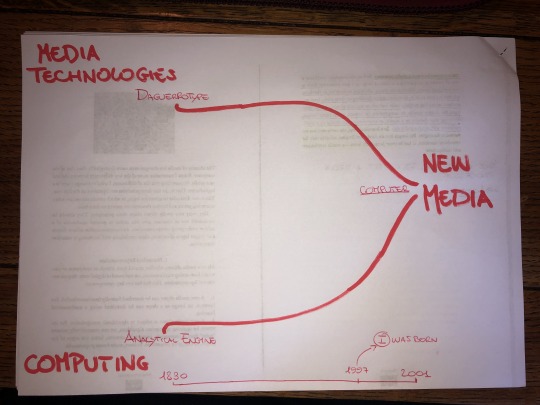Text

So, we'll go no more a roving
So late into the night,
Though the heart be still as loving,
And the moon be still as bright.
For the sword outwears its sheath,
And the soul wears out the breast,
And the heart must pause to breathe,
And love itself have rest.
Though the night was made for loving,
And the day returns too soon,
Yet we'll go no more a roving
By the light of the moon.
0 notes
Text
The end.
week 13: Jay David Bolter and Richard Grusin, “Remediation”
Maghada Kingdom, Northern India. Somewhere around 2500 years ago:

I feel you Sha’
All beautiful things must end, and so also my smart-ass blogposts have to.
SAD
But I don’t know maybe you can pool some kind of financial resources and grant me a salary to write you reviews on stuff. It’d be cool, and I’d be constantly on strike to try and negotiate a better wage because

But anyways.
Before we start this last ride about digital media, I have a kind message addressed to my dear friends Bolter & Grusin

No for real guys. Don’t get me wrong here, your paper is great and you sound like chill dudes, but
DUDE
your points are SIMPLE, and we’re all grown ups with an education. You DO NOT have to state and re-state the obvious and make multiple and equally obvious examples
LIKE, WE GET IT
Instead NO, it takes these two little bitches something like
THIRTY PAGES
to get to the main point of the essay.

But oi, maybe I get it. Maybe you were writing for some whiny-ass professor/boss who gave you a nasty word count, or maybe editorial draconian policies by the journal forced you to do this. Boh. I don’t know. Don’t wanna antagonize her but reading you kids was a tour de force.
BUT LET US NOT GET DISTRACTED LIKE WE DO ALL THE FUCKING TIME
Bolter and Grusin’s article does something quite simple: it attempts to set theoretical lineaments to the three concepts of immediacy, hypermediacy, and remediation. Very cool.
The ‘core’ of the whole essay is something pretty much like this:
Our [sick-ass neurotic] Western culture is fixated on both immediacy and hypermediation. To achieve the first, we [very reasonably and not at all pervertedly] paradoxycally construct hypermediated environments. But we do also the reverse [again great reasoning abilities here]: in going all-in for hypermediacy we tend to rely on seemingly immediate devices. All this media push-and-pull is fucking bipolar implies a logic of remediation, in which the emergence of every new media generates reciprocal ‘borrowings’ and incorporations between the new and the old.
Now Bolter. Grusin.
DOES MY PARAGRAPH LOOK THIRTY FUCKING PAGES LONG?
B & G: No
GOOD. THEN WHY THE HELL YOURS DOES?

Fucking academics, man. They drive me crazy.
So the point is that this logic of remediation is based upon the mutual dependence of contradictiory determinations (the fact that immediacy depends on hypermediacy). And well, what is it if not another episode of my highly acclaimed sit-com series
“What famous philosopher is featured in this paper?”
Our guest star today is a boy you’ve already seen in this post.

Oh yeah baby, keep those antithetical determinations struggling with each other!
And so yeah, “Immediacy depends upon hypermediacy,” and very much like an original synthesis that transcends thesis and antithesis,
“the desire for immediacy leads to a process of appropriation and critique by which digital media reshape or ‘remediate’ one another and their analog predecessors” (314).
From this point, B. & G. write words upon words to disscuss the concepts of immediacy and hypermediacy, constructing what they define a “genealogy” of the two concepts. But they means this in a very specific way. Is another guest star of “What famous philosopher is featured in this paper” coming to join us?
OF COURSE
but surprises don’t end here, because
IT’S A RETURN!

Oh yeah, your favorite bald philosophical sex symbol is back to tell you that by saying “genealogy” he means
“an examination of descent” which “permits the discovery, under the unique aspect of a trait or a concept, of the myriad events through which—thanks to which, against which—they were formed” (qtd. in 315).
Therefore Bolter and Grusin investigate the way in which these two concepts have been shaped by cultural discourse over history. Which is all fun and leisure, but not really that important to us.
One thing I did want to talk about tho is the political aspect of immediacy. So let me get this straight. When discussing VR, B&G write:
“All these enthusiasts promise us perceptual immediacy, experience without mediation. They expect virtual reality to diminish and ultimately to deny the mediating presence of the computer and its interface” (317).
Now, you have been blessed enough to encounter some Marxism in your life, you might be reminded of the crucial concept of ideology. An ideology is a set of beliefs shared by members of a society – or imposed upon them – that naturalizes artificial relationships and norms inside that community. The thing about ideologies, though, is that they are not immediately visible. They are, to borrow from B&G, transparent, because they are designed to be invisible and to provide a sense of immediacy in social dialectic. Moreover, the stronger an ideology is – the more rooted it is in culture – the less visible it is. We could say, for instance, that Mark Fisher’s concept of Capitalist Realism works as a very transparent ideology.

Rest in peace, comrade.
But going even deeper, it seems to me that this whole transparency thing is very totalitarian. Like VR is kind of totalitarian, because it seeks complete and utter control over your body and senses. Totalitarianism is like a transparent interface. It is a form of cultural VR. Or rather, ideology is a form of virtual reality.

And, oi, B&G make it clear enough that this works also when individuals have personal freedom. Sure, they’re talking about digital media, but still look at what they write:
“For if immediacy is promoted by removing the programmer/creator from the image, immediacy can also be promoted by involving the viewer more intimately in the image” (324).
That’s DEEP bruh.
Now let’s move on. So immediacy is essentially the dominant regime for much of the history of Western culture. Or at least ever since the Renaissance. It is the dream of being able to produce objects that trick us into believing that what we see is real. Fine.
Hypermediacy is sort of like its nemesis. It is the cultural regime of fragmentation, indeterminacy, multiplicity, heterogeneity and pretty much also of deliberate and explicit artificiality.
IT’S VERY POSTMODERN
VERY META-
It’s culture that is aware of its mediated nature, and breaks that suspension of disbelief stuff that makes you care for characters created by someone else.
youtube
See this at work in one of the greatest moments of digital media history.
Bolt ’n’ Grus have a lot of superfluous stuff to say about it, but unfortunately for them I am very postmodern too and my attention spans are short and so I’ll jump to remediation.
Remediation is B&S’s killer application. All their money is on this nice idea. The idea is that one of the defining characteristic of contemporary digital media – or rather, a phenomenon sparked by the emergence of them – is the fact that media represents other media in them. This, they say, can happen in four different modes.
1. Transparency: digital media highlights and re-presents an older media without any trace of irony or critique. This is like when you go search for that old album you really like on Apple Music. The platform does not ‘comment on’ the music. It just allows you to experience it by reproducing the older vynil/CD medium.

2. Emphasis on difference: digital media underlines and renders particularly evident the difference between itself and older media. Kinda like an improvement of older media through digital tools. This encompasses all the ‘expanded’ stuff you can get. Like library guides on our our library’s website. They are text-based like a physical library guide would, but they also have nice little video tutorials which improve them. Through the digital.
3. Refashoning: an ‘aggressive’ form of remediation that tries to refashion older media entirely while still signaling its presence and therefore retaining a sense of multiplicity. Here artificiality is explicit and discontinuity is visible. It is kind of like a new media collage. Something like this, perhaps:
youtube
4. Absorption and incorporation: the fourth and final mode is one in which discontinuity is minimized, because a media has entirely absorbed one or more characteristics of another one. Thus, we sort of come full circle, in the sense that absorption is superficially quite similar to transparency. Note that absorption works in both directions. Therefore you have it both in film through CGI and in videogames through cinematic cutscenes.
Our reading for this article ended with Bolter and Grusin saying that at the present moment (which for them is 1996, but non importa) all mediation is remediation, in the sense that “each medium or constellation of media […] responds to, redeploys, competes with, and reforms other media” (345). Which is also a way to offer a new connotation to the concept of media environment.
Now, sadly
WE ARE DONE.
It’s been a hell of a ride. I mean a hell. But also a ride. So we’re kind of even. It is time for me to bid you farewell; remind you to have protected sex always; assure you that, no, you won’t have panick attacks for the rest of your life (it’s the oppressive and ultra-competitive educational system’s fault); and re-assure you that, eventually, the dialectic of history will complete its cycle, unveil the inherent contradictions of capitalist societies, and prepare for the advent of a millenary communist civilization.

This come from Amazon, lol
Everything will turn out well. We will be fine. One day Donald Trump, Matteo Salvini, Boris Johnson, Marine Le Pen, Vladimir Putin, and Jair Bolsonaro will all rot in hell. We will probably have to deal with the catastrophic consequences of climate change brought about by capitalism but we’ll come out of this with a stronger, more inclusive, and more just society. Our dreams will come true and we’ll all become badass human beings who will be pillars of a reformed, humane society.
Enjoy the ride!
Today’s culture is a celebration of our struggles to become great and revolutionary individuals. Enjoy that too.
Coldplay - Lost!
youtube
William Blake, The Angel of Revelation (1805)

Adieu!
Image Sources: GIPHY, metmuseum.org, thenewpolis.com, micciacorta.it, amazon.com
1 note
·
View note
Text
Episode III: The Return of Manovich
week 11: Vincent Miller, “Key Elements of Digital Media” / Lev Manovich, “The Language of New Media”, Principles of New Media: 2. Modularity, 4. Variability, 5. Transcoding
Today I am very Happy. Even if yesterday night AS Roma lost to some unpronounceable and unspellable German team. You know why? No, it’s not because I am going out why someone I like. And neither because I decided I want to try and go to a rage room once. None of these romantics things.
NO
It’s because today, Hideo Kojima’s long-awaited and frankly strange-looking new game Death Stranding is out!

This is me being happy with the copy of the game I just bought from this pedantic guy at GameStop who really wanted to sell me their useless (and of course expensive) fidelity card. I do not fidelize. I do not permanently associate with the revolting logics of media capitalism. Btw yes that in the background is Patti Smith’s Horses signed by herself. I am so cool, I know. What can you do.
ANYWAYS
Why is this relevant? Well, for a number of reasons. First of all because a videogame is a digital object, a digital medium. So it’s important to us. Secondly, because the themes of this game are SOOOOOOO damn interesting and appropriate for what we are doing in this class.
BUT MOST IMPORTANTLY
Because I decided to have yet another theme-based post. So Ladies, Gentlment, and all the other 7456 genders out there in the wide wild world, let me introduce you to this week’s issue of my blog, which will be entirely
VIDEOGAME-THEMED

Yes, I will. Sorry not sorry.

OK so as it is now customary I will skip Miller because I don’t like riassunti and synthesis and also I want to continue my honeymoon with Manovich.

Here’s me with my boy Lev.
Today we deal with the last three of Manovich’s Principles of New Media. Today I also want to be reader-friendly so I tell all of you from the start that I am going to explain briefly the principle and then pick an example, of course from some videogame. OK fellas? Ready to go.

Principle No. 2: Modularity
Well, modularity is quite easy. Manovich uses it to explain how digital objects are assembled through independent parts, which working on their own constitute the totality of the aforementioned object. A good example from videogames is the phenomenon of pop-up textures: that thing that happens when you’re playing a game in 3D graphics which uses real-time rendering, but optimization hasn’t been done well enough (or you’re just pushing the graphics beyond your hardware capabilities) and so you get some textures to be rendered with a delay. And this sucks because, well, it’s not very realistic and it makes you realize you’re just playing a videogame.
youtube
:( this is extreme tho. Sometimes it’s just OK.
[Btw pop-up textures are essentially what Manovich is referring to at page 39 when he writes about “distancing” and “level of detail”]
Manovich refers to this also as the “fractal structure” of digital media, which very cool and very LSD-like. So, yeah, cool.
BUT EVEN COOLER THAN THIS
is how this made me think of Aristotle. Your friendly neighborhood Western-culture-generator philosopher loved to talk about how the whole of something is more than the sole value of its components. Which, in some ways, doesn’t really seem to apply completely to digital media.
SOMETHING TO REFLECT UPON
Oh. And I was also thinking that maybe, MAYBE
MAYBE
all this modularity in our daily lives is also affecting the way our minds work. Like we now struggle to create coherent, consistent (“hardwired” Manovich would say) arguments or chains of reasoning, but instead rely completely on modular frames of understanding. Like we now tend to see things as separate and independent from each other, and we have trouble in looking at the bigger picture.
“OF COURSE YOU MUST BE WRONG, WE’RE AS CAPABLE AS EVER IN UNDERSTANDING ISSUES IN THEIR TOTALITY. BUT NO KID CLIMATE CHANGE IS NOT REAL BECAUSE ADMITTING IT WOULD MEAN RECONSIDER THE PRIVILEGES I GREW UP AS EXPRESSIONS OF A POST-INDUSTRIAL COLONIAL SYSTEM OF EXPLOITATION YESTERDAY SNOWED IN BERGAMO SO NO TROUBLE”

But let us not be distracted by such irrelevant issues.

Principle No. 4: Variability
Now this is obvious but still so cool. However, the question of variability is so multifaceted and complex that is difficult to pin it down to a single definition. I’ll try my best, though. I would say that
the concept of variability refers to all the ways in which digital objects can be modified, altered, or updated at the source of their distribution.
That is, without having to physically change anything. The only thing that variability needs is some form of the refresh button. It is a sort of physically invisible mutation, a “liquid” transformation, as Manovich says. And of course this has to do with Numerical Representation, Modularity, and Automation.
Before getting into the real interesting stuff about variability, Manovich makes seven examples. A couple of them will help grasp the concept better. So yeah, example three reads like this:
“Information about the user can be used by a computer program to customize automatically the media composition as well as to create elements themselves” (37)
In that unfortunately incomplete masterpiece that Metal Gear Solid V: The Phantom Pain is, you get to play as badass Venom Snake aka (sort of...) Big Boss, a super amazing and incredibly skilled soldier who has to infiltrate military compounds and all sorts of other infiltrable things between Afghanistan and Zaire around the mid-80s. In this game, you can decide what kind of equipment to bring with you, and approach the mission the way you like best. You can bring big-ass noisy weapons and just have a crazy battles, you can use assault rifles of sniper guns with silencers and be very quiet, and you can also use guns with tranquilizers so that you don’t kill anybody. You just put them to sleep.
Now, the cool thing about it is that the more you progress in the game, the more enemy soldiers will adjust to your playing stile. For instance, I remember using only tranquilizers with pistols and sniper rifles. So I would get lots of headshots, because when you headshot someone, he instantly falls asleep. After a few missions, most of my enemies adapted and started wearing helmets! So it was much harder for me to get those headshots.
See? This is an example of automation and variability.

There is also of course example number six. The one about periodical updates. Again, for anybody who ever played a videogame online, this is usual business.

I remember I once was thirteen. Yeah I know that’s hard to imagine, but for a moment just please bear with me. When I was thirteen I was very much into multiplayer FPSs. At that time particular, me and my friends would spend entire days on Call of Duty: Black Ops. Now, the online multiplayer was constantly updated and amended, so that if someone discovered that a certain build for a weapon made that weapon totally over-powered and impossible to play against, the guys at Activision would correct the flaw and balanced the game again. But variability in the game also occurred when DLCs were released: new maps, new weapons, new elements would ‘enter’ the world of the online game and of course alter it. It was cool, really. Cause the game evolved throughout the season. But the you had to buy the new one and spend other money and start back again and… really, can we just say fuck capitalism? That game could have lasted decades. Damn.
ANYWAY
By far the most interesting thing to me came at page 40, when Manovich discusses variability in terms of interactivity and hypermedia. In particular, he distinguishes between two ‘versions’ of interactivity.
Open interactivity: an interactive object “in which both the elements and the structure of the whole object are either modified or generated on the fly in response to the user’s interaction with a program.” (40)
Closed interactivity: an interactive object “that uses fixed elements arranged in a fixed braching structure” (40) and therefore on which users have only ‘liberty of order’. That is, they can only choose in which order to interact with the elements.

Now, try to follow me for a second. I think this distinction opens up one possibility of categorizing videogames. But we need to add one more category. We have
Linear games (Super Mario, the first Metal Gear Solid, Resident Evil 4…) which display a ‘limited’, ‘scripted’ interactivity. That is: you have to follow the path that has been chosen for you by the developers. You cannot decide in which order to do things. You go ahead with the game – interact with it, sure, but you basically witness the story unfold in front of your eyes passively.
Open world games (GTA, Spiderman, Pokémon games…), which essentially function on a principle of closed interactivity. You’re free to roam around and do whatever you want, to choose your own ‘order of interaction’ with the elements on the map, but you cannot act on the storyline, which is still linear and scripted for you. The story doesn’t change, no matter what you do inside or outside of the main missions.
pure RPGs (Fallout 4, Final Fantasy, Skyrim, Mass Effect…) which instead function on a principle of open interactivity. Your choices inform the way in which the game unfolds in terms of story, world, and sometimes even gameplay. The interaction is open because it allows to be formed in response to what the player does.

I should totally write a narratology of videogames.
I’ve already written a lot and I want to get to the last principle, but
I NEED
to point out something that comes around the end of page 41. Ready? So Manovich writes:
“The principle of variability exemplifies how, historically, changes in media technologies are correlated with social change. If the logic of old media corresponded to the logic of industrial mass society, the logic of new media fits the logic of the postindustrial society, which values individuality over conformity. […] In this way new media technology acts as the most perfect realization of the utopia of an ideal society composed of unique individuals. New media objects assure users that their choices—and therefore, their underlying thoughts and desires—are unique, rather than preprogrammed and shared with others.” (41-2)
Now, I am not sure precisely where Manovich stands on this argument, but this definitely rang a bell for me.
HEY LEV, EVER HEARD OF A LAD CALLED PASOLINI?
Because yeah, digital media gave us this fantastic possibility of escaping omologation because anybody can see, read, do whatever they want without any authority providing them with univocal content.
But are we really sure this is the triumph of individuality? Couldn’t this be just a new, and much more subtle and devilish form of conformity?
My bro and spiritual-granddaddy PPP believed so. And you, he was writing in the early seventies – not long before being brutally killed by neo fascists with the complacency of the State a Roman kid in Ostia – and virtually all of his predictions are becoming a terrible reality. Because Pier Paolo believed the (back then) new consumer society (which let’s face it gave birth to digital media the way we know it today) was only a new, horrible, de-humanizing form of fascism.
youtube
This is for anybody who understands a little italian and loves tragic heroes talking about the horrors of late capitalism on winter beaches.
BUT WE HAVE TO COME TO AN END, DON’T WE?
Principle No. 5: Transcoding
I’ll be very brief, this is easy. Manovich defines transcoding starting from the difference between the “cultural layer” (pretty much the visual, the interface) and the “computer layer” (basically code) of digital media. Using the example of videogames again, the cultural layer of a videogame is all that you see happening on the screen, while the computer layer is the code ‘behind’ it that makes it all happen in that way.
Fine, cool. Transcoding, Manovich says, happens everytime these two layers—these two languages, really—start to mix and mesh with each other.
The best example that I can come up with right now—and I am sorry if I can’t think of anything better but you know I have a graceful lady waiting for me, his date—has to do again with open world videogames.
SO HERE’S THE THING, I THINK
Open world videogames emerged and became the next big thing of gaming when the internet was already a big thing. And there’s a reason for that. It’s because the structure of an open world mimics, in many ways, that of the WWW.
THINK ABOUT IT
An open world is somewhere were you can roam around (I want to say navigate so badly!) pretty much everywhere you want. Most of the times you can jump from one places to another, sometimes using a nice menu/database of possible locations (reminds you of anything? Hyperlinking? Search engines, anybody?). You can’t really create much, but you can see everything. Well, that to me sounds like WWW.
COULD IT BE LOVE? TRANSCODING?
I think it is, baby.
We’re sadly at the end of our ride
:(
But don’t be afraid!
THERE’S STILL ROOM FOR MUSIC AND VISUAL ARTS
Today we celebrate videogames, so what’s better than a collection of some classics in videogame music history? Enjoy.
youtube
As for visuals, I want to come full circle. Hideo Kojima’s game have always been blessed with amazing character design and illustrations by his bro Yoji Shinkawa. Death Stranding is no exception. Except that there is an exception, because these times the characters are actors! Great actors! Like beautiful Lea Seydoux who I hope one day to marry. Or at least to hookup with, come on. Anyways, that’s beyond my point. I just wanted to introduce this beautiful promotional picture for Death Stranding.

It really is beautiful.
до свидания!
Image Sources: Parade, Pure Nintendo, Tech in Asia, GIPHY, Know Your Meme
0 notes
Text
Episode I: Manovich Strikes Back!
week 10: Vincent Miller, “Key Elements of Digital Media” / Lev Manovich, “The Language of New Media”, Principles of New Media: 1. Numerical Representation, 3. Automation
When by my solitary hearth I sit, When no fair dreams before my “mind’s eye” flit, And the bare heath of life presents no bloom; Sweet Hope, ethereal balm upon me shed, And wave thy silver pinions o’er my head.
The past two weeks in this class have been dark as hell. The internet is a scary place dominated by Beelzebub himself, and I feel we’re all in desperate need of some hope. So I thought: why not bless you all whit some IAMBIC PENTAMETERS™ by our golden boy John Keats? Right. Here you can find the complete poem.

Here’s a recent photograph of Mark Zuckerberg with make up off.

Here’s him when his internal automation software runs smoothly.
But now
IT’S MANOVICH TIME
Just like last time I am kind of ignoring Miller because, well, it just retells Manovich so why bother with him. Except that there’s something so funny he writes about the networked nature of digital media.
OK so Miller writes:
“The decentralisation of media production means that, with many more producers and sources of information, there is a greatly enlarged element of choice when consuming digital media. (15)
Really, V?

Mr. Miller, the 2019 internet disproves your claims. Unless we wanna include the weirdos and sickos who populate the Deep/Dark web, but we’re not going that way because I already have enough anxiety with the mainstream evil and I don’t wanna get even more depressed about this terrible world.
SO
Principles of New Media. Today was quite easy, frankly. The first principle is
NUMERICAL REPRESENTATION
which, to put it bluntly, means that digital media works through binary code. That is, any digital object is actually a mathematical object, a compound of numbers. Or, if you want to be more Manovichean, a discrete object. That is, an object which is not continuous. That is, an object that can be divided and observed into little packets. Quantified. Like photons in quantum mechanics. Is this paragraph becoming annoying?
WELL WHO CARES; MY BLOG, MY STILE. IT’S DIGITIZATION OF LANGUAGE, YOU HEATHEN

Interesting.
OK so whenever we have grasped the fact that all digital media is the expression of some weird combination of numbers we can also say that this implies the possibility of algorithmic manipulation. Which of course means that those numbers can be changed and moved around pretty much the way we want. This so frickin great because it means you can make your pimples disappear on photoshop, but also frickin terrifying because it makes the manipulation of “reality” sooooo much easier that it doesn’t even require much skill anymore. And so you can be tricked into believing that you’re favorite influencer is a real person when, bè, he/she/it is in fact the result of algorithmic manipulation.
SO MUCH FOR A STABLE REALITY
Manovich also likes a lot to write about how continuous objects are turned into discrete ones through digitization, of which he says the most important/interesting aspect is that of quantification. And sooooooo he then goes on to tell you how the structuralist gang already said that LaNgUaGe Is AlWaYs QuAnTiFiEd and discrete because bla bla bla
MAYBE TRUE FOR WESTERN LANGUAGE BUT I WOULDN’T BE SO SURE ABOUT LIKE CHINESE OR JAPANESE OR SOME OTHER EXOTIC LANGUAGE
YOU EURO-CENTRIC UNIVERSALIST IMPERIALISTS
The last thing I wanted to say about PRINCIPLE NUMBER ONE is that that thing about post-industrial individual customization seems very interesting. We need more time to think about it.
BUT IT’S TIME FOR PRINCIPLE THREE AUTOMATION
Look, this word is being used so much lately that I am really starting to be pissed off. Also because it is that weirdo of Andrew Yang who makes it even more mainstream through his ridiculous 2020 campaign… I don’t know I am kinda sick of automation.
youtube
OK he’s fun. But also kind of a jerk.
But we have to talk about it so let’s start. Manovich says that automation partially removes human intentionality in the creative process, which is in itself an interesting way to look at it instead of the disgustingly dominant ideology of the:
IT MAKES THINGS EASIER
Yeah. Fuck easy, then.
Anyways, Mano-Mano distinguishes two distinct levels of automation
1. Low-level automation: the silly, simple, automatic one. The one that, like, follows blindly algorithms and patterns and responds consequently. Like the software that suggests me knew artists and album on Apple Music.

And you can see this kind of automation SUCKS SHIT because I already have both the legendary Enter The Wu-Tang and that first J. Cole album in my library. Also you really gotta be damn kidding me if you dare putting an “If” before “you like Frank Ocean.”
THERE ARE NO IFs
IT IS AN AXIOM
youtube
OK I am calming down.
2. High-level automation: this is the saucy one. The robots-are-going-to-take-over-us-and-finally-end-capitalism-because-they-know-better kind. High level automation is the one that attempts to extrapolate meaning out of objects. It is, essentially AI. Or an automation that aims to reproduce the processes through the human mind makes sense of the world.
COOL
BUT ALSO HORRIBLY DANGEROUS IF PUT IN THE HANDS OF THE WRONG PEOPLE
Of course Manovich makes the example of videogame AI. And, you know what, this example still works today, because it is the most developed and visible kind of AI.
youtube
Sometimes it doesn’t really work as well as we would like it to, though.
The last bit of Manovich is about the overabundance of information in the digital age and the way in which we try to use automation to help us navigate the IMMENSE dump that internet databases are. This is called media access, and let me tell you something: you may have the best software EVER to search around, but if:
1. You are stupid 2. Databases are put together and compiled in equally idiotic ways
You still won’t find what you’re looking for
:)
Still believe automation is going to solve all of our problems?
:)
You suck shit too, then.
:)
OK SORRY THAT WAS SAVAGE
Let me reconcile with automation enthusiasts with some pics and music. If Manovich’s book had an OST, it would sound pretty much like this, I think:
youtube
And it should have these kind of illustrations I found on the internet

وداعا !
Image Sources: wikipedia, People, Twitter
0 notes
Text
Man-ia-vich
week 9: Vincent Miller, “Key Elements of Digital Media” / Lev Manovich, “The Language of New Media”, Prologue: Vertov’s Dataset, Introduction - Mapping New Media: The Method, Ch. 1: What Is New Media?

We’ve had a week’s pause and it looks like cinema is going to play a big role in this second half of the course, so well, yeah, I decided it was a good idea to bless you with a still of one of the greatest shots in film history. Ten points to anybody who makes the rights guess on the name of the film.
OFF TO THE READINGS
Our first reading wasn’t thaaat relevant. I mean, yeah, it provided you with a sort of bird’s eye view of the status of research on this topic (i.e. digital media) but nothing too transcendental. You read about Mark Poster and his silly idyllic idea of the ‘internet model’ that generates active critical subjects and promotes a postmodern unstable identity, about Lister et al. who focus on (back then) supermega catchy phrases like hypertext, interactivity, scotomization, dispersion and bla bla bla bla bla.
BORING AF
(though I have to say Poster has a point in talking about the blurring of the distinction between producer and consumer on the internet. We, the people of the future, all are prosumers. Sadly).
The saucy stuff in Miller is all about Manovich, of course. But you know, we had to read him first hand, so maybe I better switch to the guy straight away, right?
You OK with that Miller?

Thanks a lot, Kaz.
So. Lev Manovich. Let me first spend a few words in general about the guy. I sense Imma love this man’s scriptures. I’ll tell you why:
1:
He’s RUSSIAN.
Which means badass intellectualistic and sophisticated and at times almost obscure, but you gotta love him because he has inheritend the gifts of FORMALISM.
2:
He defines himself as a DIGITAL MATERIALIST. And we all know who he is hinting at, don’t we?

It’s daddy! Yay!
3:
He’s a full-fledged philosopher who isn’t scared at all to theorize per bene and also make use of:

Yeah that is an anime representation of the young Karl Marx. Course he’s handsome as fuck.
BUT TO THE TEXT
Actually, there isn’t so much to discuss about. The Prologue is quite fascinating, but it is essentially a collection of stills from Dziga Vertov’s Man With a Movie Camera coupled with out-of-context quotes from the book. As I said, it is fascinating, stimulating, and frankly quite artistic, but it is hard to actually make something out of it if you aren’t already familiar with Manovich’s theory.
SO HERE’S ANOTHER OUT OF CONTEXT SET OF QUOTES
INTERTWINED WITH RANDOM SHOTS FROM FILMS
“A flower was offered to me, Such a flower as May never bore; But I said 'I've a pretty rose tree,' And I passed the sweet flower o'er.”

“I am not a man who approves of definitions. Labels belong on luggage as far as I’m concerned; they don’t mean anything in art.”

“the computer fulfills the promise of cinema as a visual Esperanto.”

“The demand for perfection is always a sign of a misunderstanding of the ends of art.”

“all you negative muthafuckas should look at me as inspiration. im 23 fucking years old and built a fucking monster and im not ever gonna fucking land. stop being scary and neagtive and start believing in yourself and stop living for all these other fucking idiots.”

“The cameraman, whom Benjamin compares to a surgeon, “penetrates deeply into its [reality’s] web”; his camera zooms in order to “pry an object from its shell.” Due to its new mobility, glorified in such films as Man With a Movie Camera, the camera can be anywhere, and with its superhuman vision it can obtain a close-up of any object…”

“I don't know where i'm going from here, but I promise it won't be boring”

Ten points to anybody who can detect the two Manovich quotes. Come on kids it is way too easy.
Of course the Introduction is a little bit more dense with stuff. But it is still and introduction: it essentially presents us the architecture and the basic assumptions of the book. Manovich tells us he uses film history and theory to look at digital media, he introduces the deductive concept of “digital materialism,” he mentions briefly his “Principles of New Media” – which are, by the way, numerical representation, modularity, automation, variability, and cultural transcoding – and then he specifies a little about some of his terminology.
LET’S REVIEW THIS QUICKLY
language: my man Manovich says he was scared to solicit associations with the structuralist motherfuckers theorists (my man Man, y u hate semiotics?), but then using “aesthetics” or “poetics” would have been even worse so he got stuck with language.

I can see why you wouldn’t use a e s t h e t i c s, Man.
object: he prefers it over product, artwork, interactive media, or other stuff. Doing so he wants to activate connotations that span from software lingo to 1920 Russian avant-garde and laboratory experimentation. I mean, quite an ambitious project.
BUT WE LIKE HIM THIS WAY
The only thing I am doubtful about is why not using “product” if you’re theory is infused with Marxism.

You should know better, Man.
representation: OK this is hella complicated but I’ll try. So far as Manovich says that new media objects are cultural objects (and thus participate in the construction of reality just like any other cultural artifact) I’m fine. But then he lists six different ways of connotating the word representation, and I don’t know about you, but I got kind lost there. These oppositions are:
Representation-simulation Representation-control Representation-action Representation-communication No taxation without representation Visual illusionism-simulation Representation-information
BOH
I guess I’m gonna have to read through the book.
The last few pages of the reading are very nice and come from the first chapter. Manovich bestows on us the knowledge of the fact that he’s writing approaching new media NOT in terms of consumption – as any other idiotic person who is not him in the world used to do – but primarily in terms of production.
CONGRATULATIONS! YOUR MARXISM LEVEL HAS JUST REACHED 100
So yeah, this is the big thing. Together with his historical disamina, in which he basically says that cinema and the computer aren’t that different after all. After all, they have a history in common, after all. After all.
I’ll spare you names and date. Learn from my wonderfully detailed and perfect sketch:

So computer, Manovich tells us, is fundametally a visual media. It is a machine that processes media through mathematics.
EXCITING
BUT ALSO ENOUGH FOR TODAY
SO
CULTURE
I like the fact that Manovich seems to be taking all these new approaches and be a sort of ventata d’aria fresca in the theoretical discourse. This makes me think of this song. Listen to it.
youtube
As for our painting… there is a surprise. So essentially I am so excited about this centrality of cinema in Manovich that i am giving you MORE CINEMA. So take a look at this excerpt from Luis Bunuel’s Un chien andalou, because I think it may have to do a lot with what we are talking about here.

さようなら!
Image Sources: PopMatters, vermelho.org, TeePublic, PBS, Jet d’Encre, Slant Magazine, Film School Rejects, Medium, Variety, The New Lens International, Imgur
0 notes
Text
Farticipatory culture!
week 7: Harry Jenkins, Convergence culture: Where old and new media collide, Introduction and Chapter 4

Shiiiit was reading Henry Jenkins boring. Oh my God. All those useless stories and that endless circumnavigation of issues. Man I understand you had to reach a certain wordcount to get someone to publish you but maaaaaaaaan I got so bored.
You are more than welcome to imagine that the stuff I liked about Mr. Jenkins is very little
BUT
I have to say we share a common interest in Star Wars. To honor that, I am unleashing the first FRANCHISE-THEMED post on this blog.
Yes kids! The visual content of this blog post will feature exclusively material from Star Wars!
If you like my idea you can contact me in private for donations. I would love to raise a little profit out of George Lucas’ copyrighted material because
SCREW HIM
So hit me up with your money, we shall use it to fund modern heroes fighting against the horrendous kebab imperialism of the Turkish fils de pute president.

OK here we go. Jerkin’ Mr. Jenkins has three concepts for us and
INCREDIBLY ENOUGH
none of them is particularly original. At times I fell almost like this guy is just a great affabulatore who probably got great grades in his college papers because he could babble for 2000 words without saying much of particular relevance.
BUT THIS IS JUST ME BEING NASTY
Sure.
Jenkins’ first and most important concept is that of convergence. We dumbasses who had to go through COM 220 in this university are already familiar with this word and associate it either with technological convergence or media ownership convergence. But just like that time in which the Buddha taught for 40 years straight just wake up one day and be
HOLD UP BRO IT WAS ALL A BIG EXPEDIENT TO PREPARE YOU FOR THE TRUTH OF THE
LOTUS SUTRA
Jenkins surprises us silly undergraduate with a sort of ULTIMATE MEANING of convergence. To him, convergence is neither solely about technology, nor solely about ownership. By convergence, he means
“the flow of content across ultiple media platforms, the cooperation between multiple media industries, and the migratory behavior of media audiences who will go almost anywhere in search of the kinds of entertainment experiences they want” (2)

Just the kind of definition I need the weekend before a midterm. Thanks Harry. So what I gather from this is that the converge he is talking about is essentially about content, or I mean comunque about themes and instances orbiting around a certain kind of content. Right? I guess. And so Jenkins focuses on how these kinds of contents are reproduced by and sought on different media.

Much of the rest of his introduction is Jenkins bustling with his own confused concepts to gain a degree of clarity of this stuff on convergence. Which in a way is fun to watch in itself. Because first he traces the supposedly linear history of the development of the idea – by the way quoting (and fortunately criticizing that JERK of Negroponte who believed that “monolithic empires of mass media are dissolving into an array of cottage industries” – and then he embarks on a frankly boring and useless story about this New Orleans Media Experience of 2003 about which honestly nobody gives a shit and even which even more honestly is just boring. Did I say that already? Oh sorry.
BUT IT’S TRUE
This story is infused (as frankly the rest of the stuff I have read) with a disgusting romantic notion of corporate behavior and aims, as if big media companies just couldn’t go on without including their audiences because they LOVE THEM.
FUCK NO HARRY THEY JUST WANT THEIR MONEY AND THEY’LL DO EVERYTHING IT TAKES TO SQUEEZE AS MUCH OF IT AS POSSIBLE FROM THEIR OUR POCKETS AND YOU FUCKING KNOW IT GODDAMNIT YOU TEACH AT USC IT’S NOT LIKE YOU WERE BORN YESTERDAY
I’m sorry. You may have noticed I have slight tendency in losing my temper at
MANAGERIAL CAPITALIST PIGS
No I mean with people who see things differently from me. But let us go on. By the way there is a moment in which Jenkins, talking about the way in which corporations were dealing with the emergence of convergence (I rhymed!), writes:
“The old paradigms were breaking down faster than the new ones were emerging, producing panic among those most invested in the status quo and curiosity in those who saw change as an opportunity” (7)
You what this reminds me? Look it up here. This guy first wrote it. See that part about the monsters? Does it remind you of anything? Am I implying that media giants especially of the internet are giving us a new fascism? Did you know that Charlemagne most probably didn’t want to be crowned emperor by Pope Leo III?
Unless you’re a historian of the Middle Ages, one of the answers for those last two questions is “Yes.”

Btw you should know that I decided I was heterosexual when I was 3 and went to see Phantom Menace and got acquainted with the looks of this lady up here.
Anyway. Back to convergence. Jenkins goes on and on and on and on about this talking about the different lifespans of delivery technologies and media, about his self-defined Black Box Fallacy (because to him, and he honestly has a point, while hardware diverges, content converges), about the fact that convergence is a process and not an endpoint, and about all sorts of things
UNTIL
He basically says that convergence is a top-down process as much as it is a bottom-up one. And at this point, Harry, you kinda lost me. You have used so many different and contrasting ways of defining what is it that you’re trying to define that I do not know anymore if I am reading you or fucking Spinoza. And I AM SORRY, you ain’t as cool as my lad Baruch.
So yeah I was left pretty much like this:

I think we should stick to the explanation I gave in the beginning. let us move to a second concept, which will be hopefully easier to define.
I wanna talk about collective intelligence because Jerkings only suggests it. So let me do the explanation know.
Collective intelligence was at work fo instance on the Game of Thrones’ subreddit who higitus figidus cracked the secret behind Jon Snow’s lineage YEARS before the thing was revealed in the series. Like in those beautiful communist revolutions we don’t do anymore, commoners pooled their wits and skills to fuck over the greedy and ugly masters who enslaved them. This is collective intelligence: to unionize cognitive processes and screw capital ownership.
OK maybe this was a little bit too political but you get the point right? It’s about people pooling resources and working together to solve problems or propose stuff. It’s actually quite cool. And it happens all the time on the internet. Because it’s easier to pool those cognitive resources over there.
DONE!
Let’s move to the last one.

The third point in Jenkins’ reading was participatory culture. His endless spiel about Star Wars fandom was at times interesting and times suicide-inducing. Potentially cool as a case study, but we don’t really need it for the purposes of this post. So.
The stuff we need to know is contained in the first few pages of the chapter. First of all, Jenkins rightly notes that while fandom as always existed, the internet has tipped the scales because it makes fan culture more visible. Which is in itself quite OK.
youtube
aaaaand here’s a beautiful example of Star Wars’ participatory culture.
He then distinguishes between interactivity and participation. To him, interactivity refers only to the fact that people get more feedback when they consume cultural products. Participation, he says, is deeper because it is basically in the consumer’s (I hate this word) hands: it is “open-ended” and not constrained by the decision of the designers of the original/official products. The rest of the chapter deals in ways in which companies address fan-generated content. Funnily enough, he distinguishes between prohibitionists (tight-ass douchebags who don’t want you to mess with their precious product) and collaborationists (other douchebags who instead see the staff you do as yet one more opportunity to steal time and labor from you). Nice, huh?
The funniest thing is that he chooses COLLABORATIONISTS: I mean really? You really wanna make me do that association between capitalism and fascism again? It was your choice huh.
A good example that Jenkins makes is that of game modders, who manipulate the code of videogames to construct personalized fantasies that might expand the universe of the original game, or maybe even take it to a completely new direction. Here’s an example De’Noantri:

I guess I broke my rule about Star Wars. Too bad. But I am the one who calls te shots here. I’m your lider maximo here. This is a READ ONLY blog. You shut up and read, comrade!
To reach a conclusion, the whole story of how LucasArt deals with fandom content is surely fascinating, but Jenkins repeatedly fails to look at a very important issue. When George Lucas in ANY way makes use of content created by fans, most of the times directly appropriating the copyright for it, he is
EXPLOITING
those silly fans. Instance: when the devs of Star Wars Galaxies sought fan advice for developing the game, did these fans got paid? Where are their rights? Where is the compensation for the time and labor they offered? Nowhere. And so they have been exploited, allowing George Lucas to save money on people he would have had to pay for the same services. But he had the fans he wanted to iNcLuDe…

I mean you really thought I was not going to use this?
So the conclusion is:
FANS OF ALL NATIONS, UNIONIZE!
CLAIM YOUR SHARE OF PROFIT!
DEMAND COLLECTIVIZATION OF FRANCHISES!
DEMAND LIBERALIZATION OF FAN FICTION!
DEMAND THE FUTURE!

Here you can see a visual depiction of the fandom working class rising up against bourgeoise privilege.
Since I already broke the rule, culture time will be free this week too. This is a great Russian composer who certainly influenced Williams when composing Star Wars’ music. It is one of my favorites pieces of music ever so ENJOY!
youtube
Here instead you can see Caravaggio depicting me making it barely alive out of this week’s readings:

It happens every now and then. Let’s hope next it’ll be better.
auf Wiedersehen!
Image Sources: GIPHY.com, squillace.org, wikiart.org
0 notes
Text
Lessig Come Home
week 6: Lawrence Lessig, “How Creativity is Being Strangled by the Law”
OK. OK. OK.
You may not be aware of this, but this it the third time, yes the
THIRD
THIRD
THIRD
time I try to make this post. This stupidly idiotic platform called Tumblr made my browser crash TWICE. I had written – especially the first time – amazing beautiful blogposts that would have made the history of the net, but what can you do? Well, I kinda know.
I’d like to have a little talk with the CEO of Tumblr about this. I have a couple of things to tell him

But let us not get carried away by transitory matters. We are here to discuss Lawrence Lessig, dad of Creative Commons and almost homophone to a very famous dog. Let’s get started.
OK kids I gotta say I like the guy. I watched the talk he gave at JCU a few months ago, where he stormed a magnificent papillon… I mean you gotta love this guy right? Right. So maybe you think that since I liked him I’m not gonna make fun of him?

Try again.
So. Remix. My man Lawrence starts by distinguishing two modes of culture: READ/WRITE (RW) and READ ONLY (RO). Yes, I’ll explain it to you heathens. RW is when common people get not only to consume but also to contribute to culture. Like when your friend Kevin lets out a massive burp and you decide to up the ante and respond with an equally massive burp which also conveys the blessing of spoken words. That’s RW fellas. Also like folk songs are RW. OK? RO instead is passive: it’s when normal people just shut up and experience products of culture. Like when you go to the movies (kids mi raccomando go to the movies, like in proper theatres – I promise it is so cool) and you just shut up and watch. Or when you go to a classical music concert and you shut up and listen. Or when you have reading to do and so you shut up and read. In RO you mostly shut up. It’s a tough life. But hey Johnny Cash said life is rough so you gotta be tough. So shut up and be tough.

Now read only this amazing piece of culture in homo sapiens sapiens form.
OK then Lessig talks a little about quoting and the fact that when you write your stupid papers you can do whatever the hell you want with copyrighted materials “so long as you cite.” And he basically says: “hey! why the hell can’t I do that with video stuff too?” Yeah because all this writing and theory was to advocate for his liberty to make stupid videos on Youtube while high from California weed. Weird guy this Lawrence huh.
But anyways, he says that regulation should adapt to technology and allow us to distinguish between amateurs and professionals and so and so, bla bla bla...
REMIX
Yes! That’s what my man Lessig loves. Remixes on YouTube! Because he thinks are a way to go back to RW culture after a century of RO! And so he lists them!
There are mashups…
youtube
I used to love this stuff when I was 14
And then there are anime music videos…
And then call-and-response virality…
Everything looks very interesting…
But…
It is all an excuse to say…
That this has nothing to do with technique and that today normal alphanumeric writing is like Latin in 21st century. You sure? I mean yes, academic writing is as incomprehensible as Latin to me but I mean… I don’t…
Oh right. He says “the words, images, sounds, and videos of the twenty-first century speak to the vulgar; they are the forms of expression that are understood by most people” (160). So like he’s talking about memes
EXCEPT
L you’re probably right in terms of form because yeah memes are like that, but in terms of content… I mean not really Lassie. Because memes are all about that idiotic post-ironic, nonsensical, dank stuff. Like the moth. ‘member the moth Lawrence?

Whatever. Lawrence doesn’t care ‘cause he’s got 99 problems and a bitch ain’t none. Like he’s got the problem of this F***ING copyright laws that are just out of date and useless and stupid and frankly are essentially theft so okay? Now off to the next step, comrade.
The funny one. The one in which he describes various kinds of economies (if this sounds like an episode of Friends, you are probably right my friend). So. There are three kinds of economies, Lawrence says.
Economy No. 1: commercial. Essentially pagare moneta, vedere cammello. Quid pro quo. Monetary exchange.
Economy No. 2: sharing. Like love. No money involved. What do you mean you don’t what that it’s like? Go ask my friend Melania, she can explain.
Economy No. 3: hybrid. OK so this is weird. Lassieg please define:
“An economy where a commercial entity leverages a sharing economy, or viceversa”
Mmh. And he says hybrids are eVeRyWhErE… like Flickr is an example…
Sooooo let me get this straight. No, Lawrence you can’t stop me from saying it:
THEY’RE NOT HYBRIDS
Because – like – when you have a commercial entity inside which there’s a sharing economy, you have… simply a commercial economy :)
IT’S AN ILLUSION
Yeah. I’m sorry. And you know what, my dear kulaki friend? You spotted yourself. because a few lines later you drop the magical combination of words that makes a certain iron female and very masculine Hollywood star get very excited – you write…
FREE MARKETS
Caught you bro. What a shame.

At this point, the reading is essentially over. L goes on for a while talking AGAIN about how much we should correct our obsession with copies, and how much we should end the war on piracy. But it’s not really relevant in 2019 anymore, right?
But one last thing. I wanted to thank Mr. Fancy bow tie. Because in his talk he was able to demonstrate the bottom line is that all these things relate to human behavior. That the essence of the internet’s problems is corruption. and corruption has to do with what is it that there is in our hearts. It’s about our spirit. Our driving force. Our mission. And it also means that there is no structure or technology that oppresses us. It always us oppressing us. Which is sad. But it also means that it is in our powers to change it. And we should do it. And we shall do it.
So thank you. That was encouraging and inspiring. You’ll receive a new bow tie from me around Christmas.
but
NOW
it is time for
CULTURE
OK why don’t we diversify a little the kind of music I post here, and use this opportunity to celebrate a genre which is essentially based on remix? Enjoy.
youtube
And also, why don’t I do that with art, too? Hell yeah I’m doing it. Get this Mimmo Rotella’s “Cinemascope” from 1962!

Au revoir ♥
Image Sources: Instagram, GIPHY.com, Amazon.com, bustle.com, wikiart.org, facebook.com
0 notes
Text
week 5: Richard Stallman, “Why software should not have owners” / Ryan, M., Emerson, L. & Robertson, B., “Hacker” / Gabriella Coleman, “Anonymous and the Politics of Leaking”
Alright so once again this week was less about theory and more on history and theorization (which is a different thing, folks). The readings deal with three distinct but certainly interrelated groups of dissidents and subcultures of the internet: the open source movement, hackers, and Anonymous.
Our first guests for tonight are the revolting nerds – led by fat-Jesus, Adinolfi lookalike Richard Stallman – that gave birth to the open source movement. Stallman’s article first appeared in 1994, and can be taken as a sort of manifesto for open source. In these five pages Prophet Stallman whines a lot about how wrong it is to have such a thing as proprietary software, and how software should be free in pretty much every one of its aspects. We should be free to produce, distribute, copy, amend, fix... ops, sorry: READ, FIX, ADAPT, IMPROVE software. He attacks the idea of applying copyright to digital products because of the structural differences that the digital coding has in comparison with printing, he wields a big FUCK OFF to the idea of the natural rights of autorship (somebody read Barthes, huh?), and then he goes for a detailed discussion of why it is totally ok not to pay for software because the (rich) guys who want to make custom changes for it will balance out the costs of coding. “Free software is a matter of freedom, not price” Ric from Nazareth says; “cooperation is more important than copyright” he proudly asserts (157-158).

I mean, speaking as a pirate-son-of-a-pirate how could I possibly disagree? A la mierda el proprietary software! Stallman was right and open source is a fricking great thing. Case closed. Oddio, reading between the lines I do sense a little bit of that hideous Californian Ideology™ that gravitates on the lower-right side of political compasses. But hey, you gotta give Caesar what’s Caesar’s. And hey, in a socialist country based on automation+welfare+ubi the concept of open source would flourish so why not? Good job Ric but please go shave a little I know you wanna look like Gandalf but please stop this is quite embarrassing ok?
PS: hey man I LOVE that you website looks soooo 90s! kudos to you buddy.

Thank you, Ariana. OK. Next in line we have the Hopkin’s Guide to Digital Media’s definition of “hacker.” Now, this where we get entangled with the main problem of this week’s readings: there is a lot (really, a lot) to say about those who act more or less undercover on the internet, but it appears it is hardly possible to generalize and draw conclusions. Is it because we have yet to develop the critical instruments to assess them? Is it because we’re lazy? Is it because it is Friday and it is lunchtime and I am hungry? Possibly all three of them? Yeah, possibly. It is hard to say. Hard to draw a conclusion.
Oops.
Anyways! The authors of the article do a great job in constructing a timeline of the term “hacker:” we are made aware that the first hackers appeared at MIT around the 60s, but then the term acquired new meanings during the 80s because of the phreaks movement. In the decades that followed, hacking became a sort of umbrella-term that designated the most various non-conventional activities performed through the use of technical skills with computers: hackers are tricksters, prankers, political activists, thieves, anarchists, nationalists... just name it. So I guess we better stick with the vague definition we’re provided at the beginning of the article: “a technologist with a penchant for computing [who can reach] a clever technical solution arrived at through nonobvious means.” So much for specificity.
COMUNQUE YOU DON’T HAVE A HEART IF YOU DON’T LOVE A VINTAGE HACKER:
youtube
Minute 4:35, ladies and gentlemen.
We’re left with the last and longest reading: Gabriella Coleman’s analysis on Anonymous. Clearly there is no need to get into the details of the Anonymous operations and in the way the internal organization functions. Suffice it to say that Coleman outlines a pretty clear history of how Anon was born and how it transformed but then went back to its origins.
So, Anonymous essentially was born for the LULZ on 4chan. It also takes its name from that platform because when you post on 4chan without an account you’re branded as “Anonymous”. So we’re talking about non-organized, generally non-political (or at least not actively so) individuals – some with technical skills – who started creating fusses on the internet to have a good laugh. And we all like to laugh at Scientology, right? Right. But then it changed, and for some time around 2010-2011 Anonymous became highly political in its attacks on corporations, US government, and especially in its activism during the Arab spring. But kids, one does not get rid of its roots so easily. And so Lulzsec and, later, Antisec were born as a way to reclaim the space for the lulz. I guess it was all fun and games up to certain point; the spectacle of Anonymous pranking baddies on the net was really a lot of fun. But then if you lack, as Coleman rightly points, a vision and a project, your platform is going to collapse and become basically irrelevant. And this was Anonymous inherent flaw. It is/was NOT a resistance. It was/is just a divertissement, that occasionally became political. I mean where do you think you’re going without a serious project? I dunno... I guess I just want to say that we should not take these guys too seriously. I very much believe they will not change the world.
You know who will instead?

...
Nah, just kidding. He’s a weirdo. Cool cars, eh, but come on fellas. I think he should see a therapist.
But we’re digressing! Now it is time for
CULTURE
Yayyyyyyyyyyyyyyyyyyyyyyyyyyyyyyyyyyy
OK. Here we go. In honor of my man Richard Stallman:
youtube
Sorry about that but I HAD to do it. I hope you people will understand. Let’s balance it with something more respectable. This less-famous-than-the-other-VERY-famous-version of “The Lovers” by René Magritte makes me think a lot about the anonymity of hackers on the internet. Enjoy.

Au revoir!
Image Sources: imprese-lavoro.com, GIPHY.com, Business Insider, wikiart.org
0 notes
Text
the internet’s ejaculatio praecox
week 4: “Digital society” / “Cyber Debates” / “Sociology in the age of the internet” (A. Cavanagh)
OK. These week’s readings drastically shifted from historical perspective in favor of plain and pure theory. Just the way I like it.
Our mates, our sages endowed with immense theoretical foresight and understanding are: his majesty Marshall McLuhan and his environmental understanding of media (no, man, not in that way this is no Exctinction Rebellion blog ok?); Neil Postman and Nicholas Negroponte, the two quarrelsome kids who can’t stop fighting over whether the internet is the incarnation of Satan or God, aka the cyberpessimists vs. the cyberoptimists (boring af I know); and theeeeen finally my bro Jurgen Habermas (such a manly name right?) and his badass but also fragile-ass theory of The Public Sphere. Let’s get started.
Once upon a time in Toronto (I guess) there was a man with a dream. The man was Marshall McLuhan (look at him looking at his dream here, please) and the dream was to try to understand something, even a little something, about the crazy mess of modern electronic media like radio and, especially, TV. The guy came up with a lot of theory and a lot on nice and catchy phrases like GLOBAL VILLAGE (Romans loved it so much they named a hip place in their town after it) or THE MEDIUM IS THE MESSAGE, or even HOT’N’COLD MEDIA (more of this here). My man Marshall was on fffffirrrre and for a while everybody thought he had cracked it. Then it became clear he wasn’t exactly right about exactly everything, but hey, media scholars need some of our sympathy too. Anyways, the reason why we’re still very much interested in McLuhan is because his approach was rather revolutionary: he understood media as things that function like environments – to him, media are symbolic structures, social environments that “[define] human interaction and the production of culture” (”Digital Society” 18). I mean shall we say that they are structures of possibilities for human sociality? Yes we shall. Cool guy this McLuhan huh.
To onor this great media theorist and his work, I have composed an haiku:
Marshall my Marshall:
The global village
Was in fact
Quite a load of bullshit,
But you’re still great,
And better,
Than those idiotic techno-utopians.
Let us move on to the next. Cuz we gotta deal with McLuhan children aka techno-determinsts. OK, Marshall wasn’t one of them but he certainly contributed in some way to their regrettable emergence on this planet in the digital era. OK, so. These silly buffoons believe essentially that technology shapes and determines society and the course of history, and that it absolutely doesn’t work at least also the other way around. Stupid, right? And yet they are sooooooo frickin’ liked around, both by our amicable friends in sillycon valley and by your depressed and slightly obsessive taxi driver/grandparent/whatever that thinks that the world shall be devoured by Her Satanic Majesty The Computer. Look, I can’t be bothered to write too much about these shmucks so you’ll have to settle for this: these guys l i t e r a l l y believe that either technology is the ultimate savior of humanity or its ultimate destroyer. It is stupid and it takes no account of the context in which technology is used or how people might turn upside down function and purposes of it so let’s just finish it here with my second haiku:
You guys
...
I
...
I can’t even–
OK. Postman.
You’re nice
But take it easy man.
And Negroponte:
You’re a digital nazi;
I very much dislike you.
(It’a long haiku OK?)
Hey Negroponte:

Oh, I almost forgot: at the end of this second reading there are a few nice paragraphs about how much we’re in need of a “middle ground” position in regards to the internet. I kind of agree and that’s OK. But then there is also a guy called Lawrence Lessig (I know I know he’s not just “a guy” but bear with me please) that poses the problem of internet regulation. Which I think it is a false problem. I tend to think that social factors like the internet must be regulated to ensure that nobody exploits anybody through them. The only question that should be posed is: who does it? An with what purposes?
Ok Lawrence?
Our last theory for today is that the public sphere, as it was developed by Jurgen Habermas. Such a concept is defined as a space that “exists and mediates between the mass and the power elite, an arena in which power is formed and directed” (Cavanagh 60). Unsurprisingly, this concept was obsessively and excessively associated with the internet in its early stage. Writing some twenty years later, it is evident that the internet is not (anymore?) the quintessential public sphere. But even on this, we may be tempted to ask: did it have to go like this? could we develop and handle the internet in a different way? was there the possibility of developing it into a real public sphere?
I think there was. We chose chose to go the other way though.
As Fleetwood Mac used to sing...
youtube
And now look at this public sphere depicted in “Limbo” by a follower of Hieronymus Bosch around 1575:

I always found extremely interesting that huge belly with eyes nose and face that swallows people. I wonder if that makes it similar to the internet in some ways. Surely the chaotic and absurd mess going around it does.
Good night sweet ladies, good night, good night.
Image sources: Facebook, wikimedia.org
0 notes
Text
take me home to sillycon valley
week 3: Tim O’Reilly, “What is Web 2.0″ / Richard Barbrook & Andy Cameron, “The Californian Ideology”
sooo i think that this week’s readings are in fact a truly magnificent, wondrous study case in ideology. our first reading is nothing less than a seminal blogpost by tech guru tim o’reilly on web 2.0. writing back in 2005, timmy tells us all about how the economy of the internet managed to survive after the *TOTALLY UNEXPECTED I MEAN WHENEVER ELSE THIS HAPPENED IN THE HISTORY OF CAPITALISM* dot-com crash of the year 2000. the post is a business lesson in, basically, how to develop companies like facebook or twitter – timmy from the block has got it all: the web as a platform, software as service instead of commodity, the long tail, folksonomy over taxonomy, sites that act as “middlemen” in communication... boy he had it all figured it out.
this is especially true, and particularly interesting, when our boy casually drops definitions like “architecture of participation,” “users [who] add value,” and “architecture of politics.” in these three formulations there is, frankly anything that is truly relevant about the web 2.0. to careful and hopefully critical readers, “architecture of participation” should draw attention towards the need for the web 2.0 to make users feel that they’re making the internet, that they participate in the beautiful amazing blissful perfect not-at-all-solely-for-profit enterprise of the web company. “users [who] add value” is something else we know fairly well: it refers, of course, to the economic value that users produce by using the free platform. this economic value, yes i know everybody knows it these days, is the users’ data. but the one that should really really really ring a bell to anyone who is sane enough not to be a disgusting individualist is “architecture of politics.” now. kids. can we please stop believe that nobody had figured out in advance how the internet is first and foremost a political tool? look, hey, this totally un-influential guy knew it very well in 2005. we were only mesmerized enough not to see that. and now, too bad for us, dystopia is reality and internet rigged our elections and surveillance is rampant except that it is enforced by private organizations instead of the state. which is worse. way fucking worse.
but enough with the anxiously depressive part. i wanna talk about how this is all ideological mumbo jumbo produced by the hideous neoliberal bourgeoise apparatus. and to do this i need barbrook and cameron. their article is so damn good in explaining to us young padawns how the hell could happen that hippies could ally themselves with reaganite enterpreneurs obsessed with their ridiculous ideals of dEmOcRaCy and tHe InDiViDuAl. just like all great story, that of the californian ideology starts with a fake revolution: that of the 68. ok moment of awareness 2.0: can we all please make a big big circle and repeat all together that “NO, THE 68 WAS NOT A REBELLION AGAINST THE BOURGEOISE, IT WAS JUST SPOILT BOURGEOISE KIDS MESSING UP WITH THEIR RICH PARENTS BECAUSE THEY WANTED TO SCREW MORE, MAKE MORE DEBTS, CRIPPLE ECONOMIC SYSTEMS, AND DESTROY OUR ECOSYSTEMS TO SATISFY THEIR VERY BOURGEOISE NARCISSISTIC «NEEDS»”? ok thank you kids. need that every now and then.
so, we were saying. Californian Ideology™ is a direct descendant of the 68. it is the deformed and demonic son of late capitalism. it stemmed out of two different utopias: one pathetic – the electronic agora – and one horribly dystopic – the elctronic marketplace. and it wonderfully showed us that wonderful social liberal ideals are nothing if people do not organize to contrast those who own to much wealth: as the history of the californian ideology shows us, those who want money for themselves and slavery for others always win, if they’re not contrasted harshly enough. drop that knowledge on them, comrade Mao.

and so here we come to the crucial point. as barbrook and cameron wonderfully illustrate, unfettered libertarianism and techno-utopianism leads us back to the good old plantation. except that now we’re all slaves to bezos and zuckerberg, which btw funnily enough means “sugar hill:”

anyways, remember our bro timmy? think he was explaining a neat little business plan to make us all successful cyber-enterpreneurs? no, karen, i am very sorry. he was just starting to plan world cyber-slavery. so screw him, say barbrook and cameron: the state – that is the people – should get back control over what they produced. and this is the exciting part of the article, because my new heroes barbrook and cameron subtly suggest that we should start nationalizing (yes!!!!! nationalizing!!!!!!) parts and infrastructures of the internet. and at this point i am getting so much excited because imagine give back to the people platform like facebook google and amazon, and use this operation of creating a united european public digital economy to start building...

if you’re starting to feel spicy down there in your panties, well, you’re not the only one. but now on to culture time.
first, we should appreciate of Raphael prophetized the slaughter of cyber-capitalism by a socialist EU in his 1503-05 painting “Saint George Fighting the Dragon.”

then, you may want to imagine all of this to be enforced while this song from Megadeth plays in the background.
youtube
it’s your choice you can have also Ariana Grande in the background i don’t really care.
talk to you later!
Image Sources: Reddit, DeviantArt, Web Gallery of Art
[please note that this post deliberately ignores certain conventions in punctuation because i am still experimenting on the aesthetic aspect of the blog]
#californian ideology#capitalism#techno utopia#electronic agora#electronic marketplace#megadeth#raphael#communist eu#i feel very sleepy
0 notes
Text
damn(,) the internet
week 2: James Curran, “The Internet of history”
Curran’s article is essentially divided into two distinct sections. The first one deals with the canonical history of the internet as a Western-generated and Western-centered network of infrastructures. We are informed that its current configuration is the result of an odd triad of originators: the American military-scientific complex, which led to the creation of ARPANET; its subsequent “incubation” by declining countercultural movements in the West; and the welfarist final touch given by CERN scientists, which gave birth to the WWW.
These elements of history of the early internet are then completed by the sad and widely known developments that followed what should rightfully be regarded as the “defining moment” of the life of the web: its commercialization. Curran describes all the (many) pushes and (fewer) pulls that followed the decision to open internet to the market: the first attempts to sell content on the net, the emergence of advertising, the development of a kind of softcore countercultural reaction through the open source movement, the emergence of user-generated content and social media... all things we are all very familiar with.
The second half of the article, instead, is about things we are generally less informed about: that is, of course, the history of the internet outside of the Holy Walls of the West. Curran begins by tackling the issue that catches most of the attention in Europe and the US: the role of the internet as a harbinger of liberal democracy. And of course, the conclusions are quite easy to formulate: in spite of the cyber-utopian beliefs that were generally held not even thirty years ago, the internet did not spread around tearing down autocracies. Authoritarian regimes managed to survive quite easily, and sometimes even gained points through the net.

In this sense, it is much more interesting to see Curran dispel the last remains of this messianic aura by dealing with the internet’s role in the so-called Arab spring. Through just a little statistics, our author demonstrates that, no, the internet wasn’t the agent of change in the uprisings, and most importantly that, yes, even if the internet might have participated in the lead-up to the attempted revolutions, well... the revolutions failed. Miserably. And now it seems we’ve even travelled back in time, to a world of horrible fascists, imperialism, and “geopolitical” reasons to support heads of state that frankly look and act more like butchers. Too bad, internet. Too bad.
Final paragraphs are dedicated to two other interesting issues: feminism and individualism. Such themes are of course intriguing and worth spending time on, but in Curran’s case they are only sketched, and for good reasons.
To conclude: maybe the internet did not bring anything new under the sun. After a tecno-utopian frenzy, through which we foolishly and frankly stupidly believed that a bunch of cables under the ocean would have spared us the pain of actually fighting for progress, we are now starting to realize that, hey, the internet might be a political tool, too! Better late than never.
What I find most fascinating about all of this is how, during such frenzy, almost nobody thought about the fact that maybe the internet had to be regulated like other forms of communications. Or maybe even more than others. I know, I know, I know, we’ve all read 1984 and we’re all very much scared by the thinkpol, but hey:

And now, culture time!
Each week, I will be picking a work of art and some music to make it easier to swallow the boring discussions on boring stuff such as media, politics, Pasolini’s theories on the anthropological mess brought about by consumer society, Marx’s tendency of profit’s rate to fall... you know, the usual stuff. This week’s picks are:
Francis Bacon’s Study for Portrait, 1977

and then...
youtube
Se you next week space cowboy...
Image Sources: GIPHY, amazon.com, christies.com
#internet#internet history#democracy#arpanet#counterculture#www#tim berners-lee#open source#cyber utopianism#francis bacon#cowboy bebop#good old capital#daddy Karl please come and help us#compared to trump stalin was a nice guy come on
1 note
·
View note